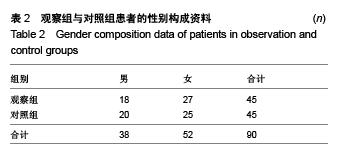| [1] Pavone V, Boettner F, Fickert S, et al. Total condylar knee arthroplasty: a long-term followup. Clin Orthop Relat Res. 2001;(388):18-25.[2] Sextro GS, Berry DJ, Rand JA. Total knee arthroplsty using cruciate-retaining kinematic condylar prosthesis.Clin Orthop Relat Res. 2001;(388):33-40.[3] Buechel FF Sr, Buechel FF Jr, Pappas MJ, et al. Twenty-year evaluation of meniscal bearing and rotating platform knee replacements. Clin Orthop Relat Res. 2001;(388):41-50.[4] Mylod Jr AG, France MP, Muser DE, et al. Perioperative blood loss associated with total knee arthroplasty. Acomparison of procedures performed with and without cementing. J Bone Joint Surg.1990;72:1010-1012.[5] Klika AK, Small TJ, Saleh A, et al. Primary Total Knee Arthroplasty Allogenic Transfusion Trends, Length of Stay, and Complications: Nationwide Inpatient Sample 2000-2009. J Arthroplasty.2014;29:2070-2077.[6] Maslovitz S, Barkai G, Lessing JB, et al. Improved accuracy of postpartum blood loss estimation as assessed by simulation. Acta Obstet Gynecol Scand.2008; 87:929-934.[7] Shaw A, Lewis RB. Methods of measuring blood loss during surgery. J Med Eng Technol.1981;5:196-197.[8] Tebruegge M, Misra I, Pantazidou A, et al. Estimating blood loss: comparative study of the accuracy of parents and health care professionals. Pediatrics. 2009; 124:e729-736.[9] Sehat KR, Evans RL, Newman JH. Hidden blood loss following hip and knee arthroplasty.Correct management of blood loss should take hidden loss into account. J Bone Joint Surg. 2004;86:561-565.[10] Klika AK, Small TJ, Saleh A, et al. Primary Total Knee Arthroplasty Allogenic Transfusion Trends, Length of Stay, and Complications: Nationwide Inpatient Sample 2000-2009. J Arthroplasty. 2014;29(11):2070-2077.[11] Mylod AG Jr, France MP, Muser DE, et al. Perioperative blood loss associated with total knee arthroplasty. A comparison of procedures performed with and without cementing. J Bone Joint Surg Am.1990;72(7):1010-1012.[12] Maslovitz S, Barkai G, Lessing JB, et al. Improved accuracy of postpartum blood loss estimation as assessed by simulation. Acta Obstet Gynecol Scand. 2008;87(9):929-934. [13] Tebruegge M, Misra I, Pantazidou A, et al. Estimating blood loss: comparative study of the accuracy of parents and health care professionals. Pediatrics. 2009;124(4): e729-736.[14] Sehat KR, Evans RL, Newman JH. Hidden blood loss following hip and knee arthroplasty. Correct management of blood loss should take hidden loss into account. J Bone Joint Surg Br. 2004;86(4):561-565.[15] Ponnusamy KE, Kim TJ, Khanuja HS.Perioperative Blood Transfusions in Orthopaedic Surgery.J Bone Joint Surg Am. 2014;96(21):1836-1844.[16] Park JH, Rasouli MR, Mortazavi SM, et al. Predictors of perioperative blood loss in total joint arthroplasty. J Bone Joint Surg Am.2013;95(19):1777-1783. [17] Rosencher N, Kerkkamp HE, Macheras G, et al. Orthopedic Surgery Transfusion Hemoglobin European Overview (OSTHEO) study: blood management in elective knee and hip arthroplasty in Europe. Transfusion.2003;43(4):459-469.[18] Xu Q, Yang Y, Shi P, et al. Repeated doses of intravenous tranexamic acid are effective and safe at reducing perioperative blood loss in total knee arthroplasty. Biosci Trends. 2014;8(3): 169-175.[19] Patel JN, Spanyer JM, Smith LS, et al. Comparison of intravenous versus topical tranexamic acid in total knee arthroplasty: a prospective randomized study. J Arthroplasty. 2014;29(8):1528-1531. [20] Di Francesco A, Flamini S, Fiori F, et al. Hemostatic matrix effects on blood loss after total knee arthroplasty: A randomized controlled trial. Indian J Orthop. 2013;47(5):474-481.[21] Aggarwal AK, Shashikanth VS, Marwaha N. Platelet-rich plasma prevents blood loss and pain and enhances early functional outcome after total knee arthroplasty: a prospective randomised controlled study. Int Orthop.2014; 38(2):387-395.[22] 马金辉,孙伟,高福强,等.关节腔注射氨甲环酸单侧全膝关节置换者的失血量及肢体周径变化:随机对照[J].中国组织工程研究, 2014,18(35):5577-5582.[23] Torres-Claramunt R, Hinarejos P, Pérez-Prieto D, et al. Sealing of the intramedullar femoral canal in a TKA does not reduce postoperative blood loss: a randomized prospective study. Knee.2014;21(4):853-857.[24] Moráis S, Ortega-Andreu M, Rodríguez-Merchán EC, et al. Blood transfusion after primary total knee arthroplasty can be significantly minimised through a multimodal blood-loss prevention approach. Int Orthop.2014;38(2): 347-354. [25] 李文,德李虎,吕厚山.改良的后关节囊止血方式对全膝关节置换术围手术期失血量的影响[J].中华外科杂志,2011,49(7): 652-653.[26] Panni AS, Cerciello S, Vasso M, et al. Knee flexion after total knee arthroplasty reduces blood loss. Knee Surg Sports Traumatol Arthrosc.2014;22(8):1859-1864.[27] Napier RJ, Bennett D, McConway J, et al. The influence of immediate knee flexion on blood loss and other parameters following total knee replacement. Bone Joint J. 2014;96-B(2): 201-209. [28] Levine BR, Haughom B, Strong B, et al. Blood management strategies for total knee arthroplasty. J Am Acad Orthop Surg. 2014;22(6):361-371.[29] Kapadia BH, Banerjee S, Issa K, et al. Preoperative blood management strategies for total knee arthroplasty. J Knee Surg. 2013;26(6):373-377. [30] Frisch NB, Wessell NM, Charters MA, et al. Predictors and complications of blood transfusion in total hip and knee arthroplasty. J Arthroplasty.2014;29(9Suppl):189-192.[31] Noticewala MS, Nyce JD, Wang W, et al. Predicting need for allogeneic transfusion after total knee arthroplasty.J Arthroplasty. 2012;27:961-967.[32] Krebs VE. Blood conservation in total joint arthroplasty. 2000 Current Concept of Joint Replacement.2000, Orlando, USA.[33] 王青,陶桂年,吕征,等.术后引流血回输在全膝关节置换术后的应用[J].中华骨科杂志,1998,11(11):702-703.[34] 冯国璋,戴号,解骏,等.自体血回输在类风湿性关节炎全膝关节置换术后的临床应用[J].国外医学:骨科分册,2004,25(5):316-318.[35] Thomassen BJ, den Hollander PH, Kaptijn HH, et al. Autologous wound drains have no effect on allogeneic blood transfusions in primary total hip and knee replacement: a three-arm randomised trial. Bone Joint J.2014;96-B:765-771.[36] Schneider MM, Kendoff D, Oloughlin PF, et al. Effectiveness of autologous transfusion system in primary total hip and knee arthroplasty.Technol Health Care.2014;22:123-128.[37] Bjerke-Kroll BT, Sculco PK, McLawhorn AS, et al. The increased total cost associated with post-operative drains in total hip and knee arthroplasty. J Arthroplasty.2014;29: 895-899.[38] Dramis A, Plewes J.Autologous blood transfusion after primary unilateral total knee replacement surgery. Acta Orthop Belg. 2006; 72: 15-17.[39] Strümper D, Weber EW, Gielen-Wijffels S, et al. Clinical efficacy of postoperative autologous transfusion of filtered shed blood in hip and knee arthroplasty.Transfusion. 2004;44:1567-1571.[40] Horstmann W, Kuipers B, Ohanis D, et al. Autologous re-transfusions drain compared with no drain in total knee arthroplasty: a randomised controlled trial. Blood Transfus. 2014;12Suppl1:s176-181.[41] Haien Z, Yong J, Baoan M, et al. Post-operative auto-transfusion in total hip or knee arthroplasty: a meta-analysis of randomized controlled trials. PLoS One. 2013;8:e55073.[42] Apostolopoulos A. The effectiveness of reinfosion after total knee replacement a prospective randomized controlled study. Int Orthop.2007;317:303-308.[43] Mirza SB, Campion J, Dixon JH, et al.Efficacy and economies of postoperative blood salvage in patients undergoing elective total hip replacement. Ann R Coll Surg Engl.2007; 89:777-784. |

.jpg)

.jpg)
.jpg)
.jpg)